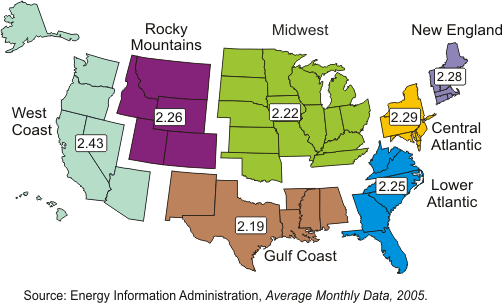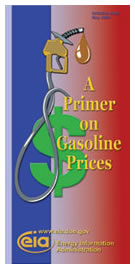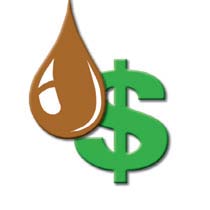A Primer on Gasoline Prices
 Click on image to down-load a printer-friendly version. Click on image to down-load a printer-friendly version. |
Gasoline, one of the main products refined from crude oil, accounts for just about 17 percent of the energy consumed in the United States. The primary use for gasoline is in automobiles and light trucks. Gasoline also fuels boats, recreational vehicles, and various farm and other equipment. While gasoline is produced year-round, extra volumes are made in time for the summer driving season. Gasoline is delivered from oil refineries mainly through pipelines to a massive distribution chain serving 168,987 retail gasoline stations throughout the United States.1 There are three main grades of gasoline: regular, mid-grade, and premium. Each grade has a different octane level. Price levels vary by grade, but the price differential between grades is generally constant.
Figure 1. What Do We Pay For in a Gallon of Regular Grade?
 |
What are the components of the retail price of gasoline?
The cost to produce and deliver gasoline to consumers includes the cost of crude oil to refiners, refinery processing costs, marketing and distribution costs, and finally the retail station costs and taxes. The prices paid by consumers at the pump reflect these costs, as well as the profits (and sometimes losses) of refiners, marketers, distributors, and retail station owners.
In 2005 the price of crude oil averaged $50.23 per barrel, and crude oil accounted for about 53 percent of the cost of a gallon of regular grade gasoline (Figure 1). In comparison, the average price for crude oil in 2004 was $36.98 per barrel, and it composed 47 percent of the cost of a gallon of regular gasoline. The share of the retail price of regular grade gasoline that crude oil costs represent varies somewhat over time and among regions.
Federal, State, and local taxes are a large component of the retail price of gasoline. Taxes (not including county and local taxes) account for approximately 19 percent of the cost of a gallon of gasoline. Within this national average, Federal excise taxes are 18.4 cents per gallon and State excise taxes average about 21 cents per gallon.2 Also, eleven States levy additional State sales and other taxes, some of which are applied to the Federal and State excise taxes. Additional local county and city taxes can have a significant impact on the price of gasoline. Refining costs and profits comprise about 19 percent of the retail price of gasoline. This component varies from region to region due to the different formulations required in different parts of the country.
Distribution, marketing and retail dealer costs and profits combined make up 9 percent of the cost of a gallon of gasoline. From the refinery, most gasoline is shipped first by pipeline to terminals near consuming areas, then loaded into trucks for delivery to individual stations. Some retail outlets are owned and operated by refiners, while others are independent businesses that purchase gasoline for resale to the public. The price on the pump reflects both the retailer’s purchase cost for the product and the other costs of operating the service station. It also reflects local market conditions and factors, such as the desirability of the location and the marketing strategy of the owner.
1National Petroleum News, May 2005.
2Energy Information Administration, Petroleum Marketing Monthly April 2006,
Table EN1 at: http://www.iea.doe.gov/pub/oil_gas/petroleum/data_publications
petroleum_marketing_monthly/current/pdf/enote.pdf
Factors Behind the Increase in Gasoline Prices in 2005 |
Since the beginning of 2005, U.S. retail gasoline prices have been generaly increasing, with the average price of regular gasoline rising from $1.78 per gallon on January 3 to as high as $3.07 per gallon on September 5, as Hurricane Katrina further tightened gasoline supplies. But the hurricane is only one factor, albeit a dramatic one, which has caused gasoline prices to rise in 2005.
A major factor influencing gasoline prices in 2005 was the increase in crude oil prices. The price of West Texas Intermediate (WTI) crude oil, which started the year at about $42 per barrel, reached $70 per barrel in early September. Crude oil prices rose throughout 2004 and 2005, as global oil demand increased dramatically, stretching capacity along the entire oil market system, from crude oil production to transportation (tankers and pipelines) to refinery capacity, nearly to its limits. With minimal spare capacity in the face of the potential for significant supply disruptions from numerous sources, oil prices were high throughout 2005.
In addition, Hurricane Katrina had a devastating impact on U.S. gasoline markets, initially taking out more than 25 percent of U.S. crude oil production and 10-15 percent of U.S. refinery capacity. On top of that, major oil pipelines that feed the Midwest and the East Coast from the Gulf of Mexico area were shut down or forced to operate at reduced rates for a significant period. With such a large drop in supply, prices spiked dramatically. Because two pipelines that carry gasoline were down initially, some stations actually ran out of gasoline temporarily. However, once the pipelines were restored to full capacity and some of the refineries were restarted, retail prices began to fall. Increased gasoline imports in the fall of 2005, in part stemming from the International Energy Agency’s emergency release, also added downward pressure to gasoline prices. However, retail prices are likely to remain elevated as long as some refineries remain shut down and the U.S. gasoline market continues to stretch supplies to their limit. |
Why do gasoline prices fluctuate?
Even when crude oil prices are stable, gasoline prices normally fluctuate due to factors such as seasonality and local retail station competition. Additionally, gasoline prices can change rapidly due to crude oil supply disruptions stemming from world events, or domestic problems such as refinery or pipeline outages.
Seasonality in the demand for gasoline - When crude oil prices are stable, retail gasoline prices tend to gradually rise before and during the summer, when people drive more, and fall in the winter. Good weather and vacations cause U.S. summer gasoline demand to average about 5 percent higher than during the rest of the year. If crude oil prices remain unchanged, gasoline prices would typically increase by 10-20 cents from January to the summer.
Changes in the cost of crude oil - Events in crude oil markets were a major factor in all but one of the five run-ups in gasoline prices between 1992 and 1997, according to the National Petroleum Council’s study, U.S. Petroleum Supply - Inventory Dynamics. About 47 barrels of gasoline are produced from every 100 barrels of crude oil processed at U. S. refineries, with other refined products making up the remainder.
Crude oil prices are determined by worldwide supply and demand, with significant influence by the Organization of Petroleum Exporting Countries (OPEC). Since it was organized in 1960, OPEC has tried to keep world oil prices at its target level by setting an upper production limit on its members. OPEC has the potential to influence oil prices worldwide because its members possess such a great portion of the world’s oil supply, accounting for about 40 percent of the world’s production of crude oil and holding more than two-thirds of the world’s estimated crude oil reserves. Additionally, increased demand for gasoline and other refined products in the United States and the rest of the world is also exerting upward pressure on crude oil prices.
Rapid gasoline price increases have occurred in response to crude oil shortages caused by, for example, the Arab oil embargo in 1973, the Iranian revolution in 1978, the Iran/Iraq war in 1980, and the Persian Gulf conflict in 1990. Gasoline price increases in recent years have been due in part to OPEC crude oil production cuts, turmoil in key oil producing countries, and problems with petroleum infrastructure (e.g., refineries and pipelines) within the United States. Additionally, increased demand for gasoline and other petroleum products in the United States and the rest of the world is also exerting upward pressure on prices.
Product supply/demand imbalances - If demand rises quickly or supply declines unexpectedly due to refinery production problems or lagging imports, gasoline inventories (stocks) may decline rapidly. When stocks are low and falling, some wholesalers become concerned that supplies may not be adequate over the short term and bid higher for available product. Such imbalances have occurred when a region has changed from one fuel type to another (e.g., to cleaner-burning gasoline) as refiners and marketers adjust to the new product. Gasoline may be less expensive in one summer when supplies are plentiful vs. another summer when they are not. These are normal price fluctuations, experienced in all commodity markets. However, prices of basic energy (gasoline, electricity, natural gas, heating oil) are generally more volatile than prices of other commodities. One reason is that consumers are limited in their ability to substitute between fuels when the price for gasoline, for example, fluctuates. So, while consumers can substitute readily between food products when relative prices shift, most do not have that option in fueling their vehicles.
Figure 2. Motor Gasoline Prices at Retail Outlets, 2005 Average Regular Grade,
by Region
(dollars per gallon, including taxes)
 |
Why do gasoline prices differ according to region?
Although price levels vary over time, Energy Information Administration (EIA) data indicate that average retail gasoline prices tend to typically be higher in certain States or regions than in others (Figure 2). Aside from taxes, there are other factors that contribute to regional and even local differences in gasoline prices:
Proximity of supply - Areas farthest from the Gulf Coast (the source of nearly half of the gasoline produced in the United States and, thus, a major supplier to the rest of the country), tend to have higher prices. The proximity of refineries to crude oil supplies can even be a factor, as well as shipping costs (pipeline or waterborne) from refinery to market.
Supply disruptions - Any event which slows or stops production of gasoline for a short time, such as planned or unplanned refinery maintenance, can prompt bidding for available supplies. If the transportation system cannot support the flow of surplus supplies from one region to another, prices will remain comparatively high.
Competition in the local market - Competitive differences can be substantial between a locality with only one or a few gasoline suppliers versus one with a large number of competitors in close proximity. Con-sumers in remote locations may face a trade-off between higher local prices and the inconvenience of driving some distance to a lower- priced alternative.
Environmental programs - Some areas of the country are required to use special gasolines. Environmental programs, aimed at reducing carbon monoxide, smog, and air toxics, include the Federal and/or State-required oxygenated, reformulated, and low-volatility (evaporates more slowly) gasolines. Other environmental programs put restrictions on transportation and storage. The reformulated gasolines required in some urban areas and in California cost more to produce than conventional gasoline served elsewhere, increasing the price paid at the pump.
| Why are California gasoline prices higher and more variable than others? |
The State of California operates its own reformulated gasoline program with more stringent requirements than Federally-mandated clean gasolines. In addition to the higher cost of cleaner fuel, there is a combined State and local sales and use tax of 7.25 percent on top of an 18.4 cent-per-gallon Federal excise tax and an 18.0 cent-per-gallon State excise tax. Refinery margins have also been higher due in large part to price volatility in the region.
California prices are more variable than others because there are relatively few supply sources of its unique blend of gasoline outside the State. California refineries need to be running near their fullest capabilities in order to meet the State’s fuel demands. If more than one of its refineries experiences operating difficulties at the same time, California’s gasoline supply may become very tight and the prices soar. Supplies could be obtained from some Gulf Coast and foreign refineries; however, California’s substantial distance from those refineries is such that any unusual increase in demand or reduction in supply results in a large price response in the market before relief supplies can be delivered. The farther away the necessary relief supplies are, the higher and longer the price spike will be.
California was one of the first States to ban the gasoline additive methyl tertiary butyl ether (MTBE) after it was detected in ground water. Ethanol, a non-petroleum product usually made from corn, is being used in place of MTBE. Gasoline without MTBE is more expensive to produce and requires refineries to change the way they produce and distribute gasoline. Some supply dislocations and price surges occurred in the summer of 2003 as the State moved away from MTBE. Similar problems have also occurred in past fuel transitions. |
Due to the threat of groundwater contamination, the use of the gasoline additive MTBE has been in the process of being phased-out for several years. More than half of the States have already banned the use of MTBE; the heaviest use of MTBE is currently in Texas and the Northeast, exclusive of New York and Connecticut. In 2005, a number of petroleum companies announced their intent to stop using MTBE in their gasoline in 2006. This was due to perceived potential for increased liability exposure due to the elimination of the oxygen content requirement for reformulated gasoline (RFG) included in the Energy Policy Act of 2005. Most of these companies will instead blend in ethanol to help replace the octane and clean-burning properties of MTBE. The rapid switch from MTBE to ethanol could have several impacts on the market that serve to increase the potential for supply disruptions and subsequent price volatility on a local basis. California faced temporary supply dislocations and price volatility during the summer of 2003 as MTBE was removed from gasoline in the State. Nevertheless, New York and Connecticut had a relatively smooth transition phasing out MTBE in 2004 as a result of better preparation from the gasoline suppliers and distributors. The supply and distribution system must undergo a number of changes to switch from MTBE-blended RFG to ethanol blended RFG, including developing supply chains to move more ethanol into undersupplied areas, converting terminal tanks from petroleum to ethanol, and adding blending equipment at terminals. It is expected that reformulated gasoline areas on the East Coast, especially in the Mid-Atlantic, will experience the most trouble obtaining ethanol supplies in a timely fashion due to logistical challenges of getting ethanol to and from terminals further inland by rail car. The Dallas-Fort Worth and Houston areas may also experience some trouble getting ethanol to major terminals due to limited rail access.
Operating costs - Even stations located adjacent to each other have different traffic patterns, rents, and sources of supply that influence retail price.
This brochure is available at:
http://tonto.eia.doe.gov/reports/reportsD.asp?type=other
For links to current gasoline prices and analyses, see:
http://tonto.eia.doe.gov/oog/info/gdu/gasdiesel.asp
The Energy Information Administration(EIA) is an independent statistical agency, within the U.S. Department of Energy. whose sole purpose is to provide reliable and unbiased energy information.
For further information, contact:
National Energy Information Center, NEIC
Energy Information Administration
1000 Independence Ave., SW
Washington, DC 20585
Telephone: 202.586.8800, 9:00am-5:00pm Eastern time.
E-mail: infoctr@eia.doe.gov---normal response is 3 business days.
Other consumer-oriented brochures can be accessed on the Web at: http://tonto.eia.doe.gov/reports/reportsA.asp?type=other
EIA’s Web Site:
www.eia.doe.gov |



